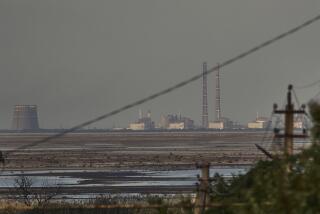Risk of meltdown increases at Japan nuclear reactor
The fuel rods at a third nuclear reactor at the Fukushima No. 1 nuclear power plant have been fully exposed to air for short periods of time and at least partially exposed for more than three hours, allowing them to heat up and sharply raising the risk of a meltdown, according to officials of the Tokyo Electric Power Co., which owns the plant.
The cooling problems at reactor No. 2 represent the most serious development in the ongoing problems at the nuclear power plant to date, according to nuclear specialist Edwin Lyman of the Union of Concerned Scientists.
Engineers had begun using firehoses to pump seawater into the reactor at the facility, the third reactor to receive the last-ditch treatment, after the plant’s emergency cooling system had failed and the fuel rods had been partially exposed to the air.
Photos: Scenes of earthquake destruction
Company officials said the workers were not paying sufficient attention to the process, however, and let the pump run out of fuel, allowing the fuel rods to become exposed.
Once the pump was restarted and water flow was restored, another worker inadvertently closed a valve that was designed to vent steam from the containment vessel. As pressure built up inside the vessel, the pumps could no longer force water into it and the fuel rods were once more exposed.
The company said it was confident it could reopen the valve and restore water flow, but it has not yet announced that it has done so. Officials are now talking about spraying seawater on the outside of the reactor vessel to help cool it.
No one knows how much damage has been done to the fuel rods, either in this reactor or in reactors No. 1 and No. 3, where engineers began pumping in seawater over the weekend.
Officials have called the situation a partial meltdown because they have detected minute quantities of radioactive cesium and iodine — byproducts of the nuclear fission that powers the reactor — outside the plant. That may mean simply that the zirconium cladding that sheathes the uranium fuel pellets has cracked due to heat from being exposed to the air, allowing small quantities of the radionuclides to escape, or it may mean that the fuel pellets themselves have partially melted.
As long as the reactor containment vessel remains intact, however, no one will know until workers can physically examine the fuel rods for damage.
Because it is now more than three days after the shutdown of the nuclear reactors, the cores are producing substantially less heat than they were immediately after the shutdown, which is a hopeful sign for efforts to cool the reactors.
Nonetheless, the uranium pellets in the fuel rods are still generating sufficient heat to melt if they remain exposed to air for several hours. If that were to happen, they would drip and fall to the bottom of the reactor. There is likely to be more water there, which would help cool the uranium, perhaps resolidifying it.
But if enough uranium melted and accumulated in the bottom of the reactor, it could grow hot enough to melt through the concrete and steel base and enter the ground, where it would create a massive cloud of radioactive steam and ash that could spread for miles.
Officials of Tokyo Electric Power Co. said conditions are stable at reactors No. 1 and No. 3 and that the cooling seems to be working.
An explosion at reactor No. 3 on Sunday destroyed the outer building at the reactor and injured 11 workers, but did not damage the reactor containment vessel.
A similar explosion at reactor No. 1 earlier in the weekend damaged that building and released what is said to be small amounts of radiation into the environment. Three workers at the plant have been hospitalized for radiation exposure, but it is not clear how much radiation they received. At least 20 civilians have had radiation detected on their clothes, but U.S. experts believe their exposure was minimal.
A U.S. warship sailing off the coast of Japan reported that it sailed through a small plume of radiation from the plant, but has successfully decontaminated both the ship and sailors. Others that were near the coast in the area of the reactors have been pulled away.
Japanese authorities have so far reported no radiation release from the explosion at the No. 3 reactor.
Authorities fear that the injection of seawater into the No. 2 reactor and the exposure of the fuel rods to air could lead to a buildup of hydrogen gas and an explosion at that plant as well.
Photos: Scenes of earthquake destruction
In the unlikely event of a meltdown that escaped the reactor containment vessel, authorities would most likely have to entomb the reactor in concrete, as was done at Chernobyl. If the escaping radioactivity was sufficiently intense, they might also be forced to evacuate the workers trying to control conditions at the other reactors on the site, which could lead to meltdowns in those reactors as well.





